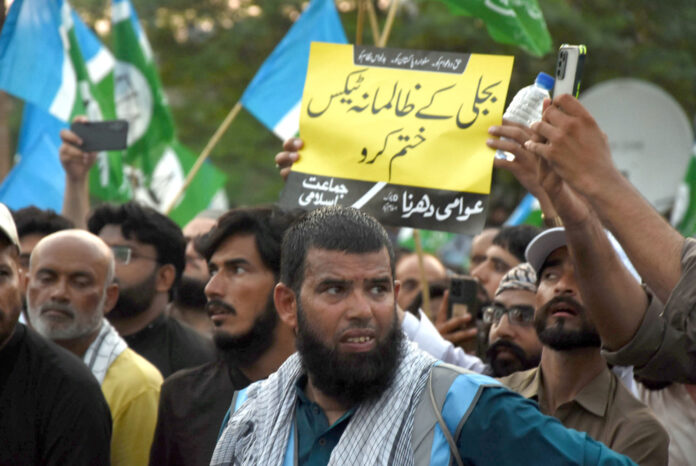 Amjad Mehmood
Amjad Mehmood
—Islamabad, the nation’s capital of Pakistan, is renowned for its meticulously planned infrastructure, tranquil ambiance, and dynamic community life. It hosts a variety of local enterprises, corporate headquarters, and governmental entities, including ministries, judicial bodies, and healthcare facilities. Furthermore, the city is adorned with numerous educational establishments, ranging from elementary schools to esteemed universities. However, in recent times, Islamabad has emerged as a focal point for political and religious demonstrations, profoundly affecting the everyday lives of its inhabitants and inflicting considerable economic and societal harm.
Since 2014, the frequency of political and religious protests in Islamabad has escalated, notably since the Pakistan Tehreek-e-Insaf (PTI) initiated a significant sit-in in the city. These demonstrations, frequently held on principal thoroughfares such as Faizabad, have paralyzed the capital, causing substantial inconvenience to its residents. A prime example is the Tehreek-e-Labbaik Pakistan (TLP)’s protest at Faizabad, which led to extensive road blockades and widespread disturbances. This prolonged protest underscored the grave repercussions of such gatherings, with major thoroughfares impassable, hindering commuting, and causing delays in essential services like healthcare. Educational institutions had to close, interrupting the education of countless students, and businesses suffered significant losses due to decreased accessibility and employee absence. TLP staged their protest a couple of weeks before at Faizabad in the name of Palestine freedom allegedly through the support of old sponsors. In 2019, Azadi march was an 18-day long protest led by Maulana Fazl-ur-Rehman of Jamiat Ulema-e-Islam (F) in Islamabad against the PTI-Led government making Sri-Nagar Highway a picnic point. On July 26, the Jamaat-e-Islami started their protests against the huge utility bills and taxes and staged a sit-in at Liaqat-Bagh Rawalpindi by halting the life at Murree road and adjacent areas. Such sit-ins in the name of public, enveloped the public lives in turmoil and frustration.
Over the years, Islamabad has witnessed a concerning trend where government and city administration simply place the containers on major entry points of the capital—a seemingly childish and foolhardy measure to stop the protests. This tactic, while intended to restrict movement, actually amplify the message of the protesters and inadvertently made life increasingly difficult for ordinary citizens. The blockade of major roads led to severe traffic congestion, extending commute times exponentially and straining the patience of residents who rely on these routes for their daily routines. This approach not only undermines the quality of life for Islamabad’s inhabitants but also raises serious questions about the wisdom and efficacy of such actions in achieving the desired outcomes.
The impacts of these protests are far-reaching, affecting both the social structure and the economy of Islamabad. Traffic disruptions are among the most immediate and apparent effects, with major routes and intersections often sealed off, resulting in lengthy traffic jams. This not only inconveniences commuters but also impedes emergency services, potentially endangering lives. Hospitals are particularly affected, with patients, especially those in critical condition, struggling to reach medical facilities on time. During the Faizabad protest, there were instances of ambulances being trapped in traffic for extended periods, with some patients succumbing to their illnesses before reaching the hospital. The psychological strain on patients and their families is immense, compounding an already dire situation.
Educational institutions bear another brunt of the protests. Schools and universities often have to suspend operations, disrupting the education of thousands of students. Examinations are postponed, classes are cancelled, and academic schedules are disrupted, affecting student learning and adding to the administrative burdens on educational institutions. Fear, extra-precaution or wish, people employed in government, private offices and educational institutions throughout Islamabad have adopted the practice of abandoning their duties in the middle and rushing back to homes without truly considering the actual circumstances.
The economic fallout from protests is also considerable. Businesses, especially those situated near protest sites, incur substantial losses. Reduced footfall, employee absences, and logistical difficulties contribute to revenue declines. Estimates suggest that the Faizabad protest alone led to millions of rupees in losses for local businesses. The long-term economic damage includes a loss of investor confidence, with potential investors deterred by the instability in the capital city.
Given the substantial social and economic costs of protests in Islamabad, there is an urgent need for a solution that harmonizes the right to protest with the necessity to preserve public order and safety. One feasible solution is the establishment of a designated protest zone on the periphery of the capital. This would enable protesters to exercise their democratic rights without disrupting the daily lives of Islamabad’s residents. Numerous countries worldwide have successfully implemented designated protest zones. For instance, the National Mall in Washington, D.C., serves as a common venue for large-scale demonstrations in the United States, and Hyde Park in London houses a designated area known as Speakers’ Corner for public expression. These examples illustrate that accommodating protests in a manner that minimizes public disruption is achievable.
A designated protest area in Islamabad could be situated in a location that is easily accessible yet sufficiently distant from the city center to mitigate major disruptions. The area could be equipped with necessary amenities such as sanitation, first aid, and security to ensure the safety and comfort of protesters. This approach would offer several advantages, including reduced traffic congestion and disruptions to public services. Commuters would be able to travel without the fear of encountering road blockages, and emergency services would remain unimpeded. A designated area would facilitate better crowd management and security measures, lowering the risk of violence and safeguarding the welfare of both protesters and the general public. Law enforcement agencies could concentrate their resources on maintaining order in a controlled setting. Protesters would still be able to exercise their democratic rights in a visible and impactful manner, without infringing upon the rights of other citizens. This strategy would uphold the principles of freedom of speech and assembly while ensuring that these rights do not compromise public order. Businesses would experience fewer disruptions, contributing to economic stability and investor confidence. The local economy would benefit from diminished losses and enhanced productivity.
The government bears the responsibility to safeguard the rights of all citizens, encompassing the right to protest and the right to live without undue disturbance. Implementing a policy that designates a specific area for protests would signify a commitment to balancing these rights. It would also represent a proactive stance towards managing civil unrest and ensuring public well-being. To realize this, the government could undertake several steps. Firstly, passing legislation that designates a specific area for protests and delineates the rules governing its usage would provide a clear legal framework for managing demonstrations. Additionally, the government could develop the designated protest area with the necessary infrastructure and facilities to ensure the safety and comfort of protesters, including sanitation, medical services, and security measures. To familiarize citizens with the legislation and protocol of protest, the government could launch a public awareness campaign to inform citizens about the new policy and the designated protest area. This would assist in ensuring compliance and mitigating confusion during the implementation phase. Engaging with political, religious, and other potential protesting groups to elucidate the benefits of the designated protest area and solicit their cooperation would help foster consensus and diminish resistance to the new policy.
The surge in protests in Islamabad underscores the need for a balanced approach to managing civil unrest. While the right to protest is a fundamental democratic principle, it should not supersede public order and safety. Establishing a designated protest area on the outskirts of Islamabad offers a viable solution, enabling citizens to exercise their rights without disrupting the daily lives of others. By proactively implementing this policy, the government can safeguard the well-being of Islamabad’s residents, ensure the city’s smooth operation, and uphold the principles of democracy. It is time for a shift that acknowledges the rights of all citizens and fosters a more stable and prosperous future for Islamabad.



